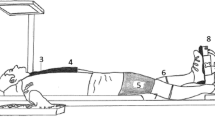Abstract
We examined the relationship between portal venous blood flow and sympathoadrenergic activation after muscle exercise. For this purpose, we used echo Doppler and measured plasma noradrenaline concentration before and after mild (7 metabolic units,N=8) and maximal exercise (14 metabolic units,N=8) in 16 patients without significant disease. Portal venous flow did not change after mild exercise. In contrast, a significant reduction in portal venous flow was observed after maximal exercise (P<0.01). This was due to reductions in both cross-sectional area of the portal vein (P<0.01) and portal venous velocity (P<0.01). Overall, there were significant inverse relationships between the change in plasma noradrenaline concentration and that in cross-sectional area of the portal vein [r=−0.44,P<0.01 (absolute change);r=−0.47,P<0.01 (relative change)], that in portal venous velocity (r=−0.63,P<0.01;r=−0.61,P<0.01), and that in portal venous flow (r=−0.54,P<0.01;r=− 0.59,P<0.01). These results suggest that the reduction in portal venous flow after exercise is related to the degree of sympathoadrenergic activation. This reduction may be due mainly to splanchnic vasoconstriction.
Similar content being viewed by others
References
Ohnishi K, Saito M, Nakayama T, Iida S, Nomura F, Koen H, Okuda K: Portal venous hemodynamics in chronic liver disease: Effects of posture change and exercise. Radiology 155:757–761, 1985
Alvarez D, Mastai R, Lennie A, Soifer G, Levi D, Terg R: Noninvasive measurement of portal venous blood flow in patients with cirrhosis: Effects of physiological and pharmacological stimuli. Dig Dis Sci 36:82–86, 1991
Moneta GL, Taylor DC, Helton WS, Mulholland MW, Strandness DE Jr: Duplex ultrasound measurement of postprandial intestinal blood flow: Effect of meal composition. Gastroenterology 95:1294–1301, 1988
Pugllies D, Ohnishi K, Tsunoda T, Sabba C, Albano O: Portal hemodynamics after meal in normal subjects and in patients with chronic liver disease studied by echo-Doppler flowmeter. Am J Gastroenterol 82:1052–1056, 1987
Sabbá C, Ferraioli G, Genecin P, Colombato L, Bunamico P, Lerner E, Taylor KJW, Groszmann RJ: Evaluation of postprandial hyperemia in superior mesenteric artery and portal vein in healthy and cirrhotic humans: An operator-blind echo-Doppler study. Hepatology 13:714–718, 1991
Gaiani S, Bolondi L, Bassi SL, Santi V, Zironi G, Barbara L: Effect of meal on portal hemodynamics in healthy humans and in patients with liver disease. Hepatology 9:815–819, 1989
Iwao T, Toyonaga A, Ikegami M, Oho K, Sumino M, Sakaki M, Shigemori H, Tanikawa K, Iwao J: Reduced portosystemic hemodynamic responsiveness after orthostasis in patients with cirrhosis. Dig Dis Sci 38:1251–1258, 1993
Buttrick PM, Scheuer J: The Heart, 7th ed. New York, McGraw-Hill, 1990, pp 1479–1488
Mitchell JH, Blomqvist G: Maximal oxygen uptake. N Engl J Med 284:1018–1022, 1971
The Preventive and Rehabilitative Exercise Committee of the American College of Sports Medicine: Guidelines for exercise testing and prescription, 4th ed. RR Pate (ed). Philadelphia, Lea & Febiger, 1991, pp 55–91.
Gill RW: Pulsed Doppler with B-mode imaging for quantitative blood flow measurement. Ultrasound Med Biol 5:223–235, 1979
Yamatodani A, Wada H: Automated analysis for plasma epinephrine and norepinephrine by liquid chromatography, including a sample cleanup procedure. Clin Chem 27:1983–1987, 1981
Wallenstein S, Zucker CL, Fleiss JL: Some statistical methods useful in circulation research. Circ Res 47:1–9, 1980
Author information
Authors and Affiliations
Rights and permissions
About this article
Cite this article
Iwao, T., Toyonaga, A., Ikegami, M. et al. Effects of exercise-induced sympathoadrenergic activation on portal blood flow. Digest Dis Sci 40, 48–51 (1995). https://doi.org/10.1007/BF02063940
Received:
Revised:
Accepted:
Issue Date:
DOI: https://doi.org/10.1007/BF02063940




